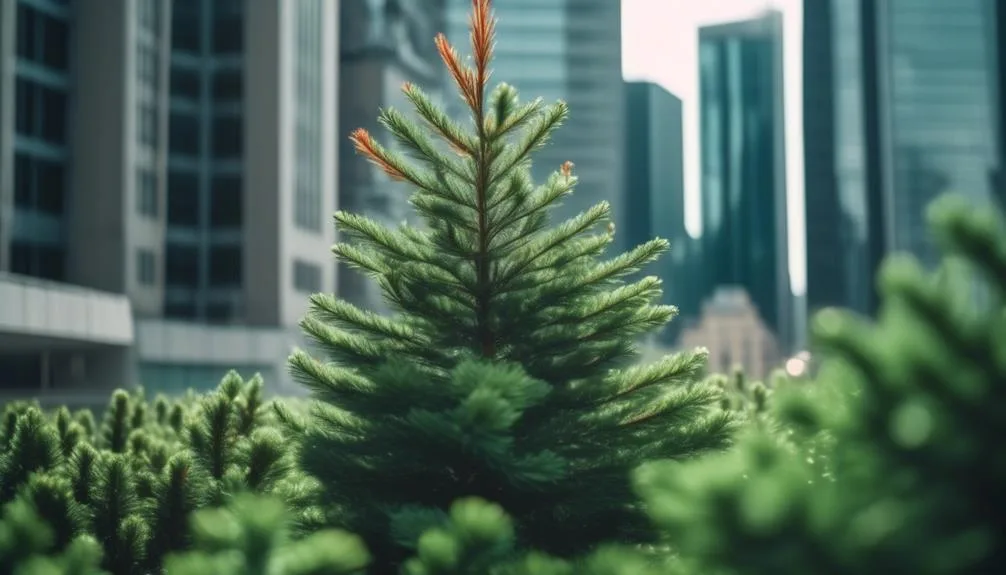In the midst of a busy city, spotting a single spruce tree towering above the urban bustle can be quite a sight. It's a complex topic worth exploring, from the benefits and challenges of having these majestic trees in urban areas to the environmental impact. This raises the question – can spruce trees really thrive in the midst of all this concrete and noise? Let's take a closer look at the world of urban spruce trees and the strategies for their successful growth in this unlikely environment.
Benefits of Spruce Trees in Urban Environments
In urban environments, spruce trees provide numerous benefits. They improve air quality, reduce noise, and enhance the aesthetic appeal of the area. Spruce trees play a vital role in air purification by absorbing harmful pollutants like carbon dioxide, sulfur dioxide, and nitrogen dioxide. They release oxygen into the atmosphere, contributing to the overall improvement of air quality. This creates a healthier environment for urban dwellers. Additionally, the dense foliage of spruce trees serves as a natural barrier, effectively reducing noise pollution in bustling city settings. The aesthetic appeal of spruce trees also enhances the urban landscape, providing a sense of tranquility and natural beauty amidst the concrete jungle. These ecosystem benefits make spruce trees a valuable addition to urban environments. They promote cleaner air, quieter surroundings, and a more visually pleasing cityscape.
Challenges of Growing Spruce Trees in Cities
Growing spruce trees in urban environments presents unique challenges that can impact their ability to continue providing benefits such as improved air quality, noise reduction, and aesthetic appeal.
Soil quality is a significant concern as urban soil tends to be compacted, limiting water and nutrient absorption crucial for tree growth. Additionally, air pollution can adversely affect spruce trees, leading to stunted growth, foliage damage, and increased susceptibility to pests and diseases. High levels of pollutants such as ozone and particulate matter can hinder photosynthesis and overall tree health.
To combat these challenges, urban forestry programs often employ specialized soil management techniques, such as aeration and mulching, to improve soil conditions. Furthermore, proactive measures to reduce air pollution, such as planting more trees and implementing emission controls, are crucial for the successful growth of spruce trees in cities.
Environmental Impact of Urban Spruce Tree Growth
When cultivating spruce trees in urban settings, you may notice a significant environmental impact on air quality and overall ecosystem health. Urban pollution, including vehicle emissions and industrial activities, can affect the health of spruce trees. These trees play a crucial role in mitigating urban pollution by trapping airborne particles on their needles and absorbing harmful gases through their stomata.
However, prolonged exposure to high levels of urban pollution can lead to reduced tree health, affecting their growth and overall vitality. Additionally, the presence of spruce trees in urban environments can contribute to improved air quality by filtering out pollutants and providing shade, ultimately benefiting the surrounding ecosystem.
Therefore, it's important to consider the environmental impact of urban spruce tree growth and implement measures to mitigate the effects of urban pollution on tree health.
Strategies for Promoting Spruce Tree Growth in Urban Areas
To foster the thriving growth of spruce trees in urban areas, employ strategic planting techniques and regular maintenance to ensure their health and resilience amidst urban challenges. Consider the following strategies:
- Soil management: Utilize appropriate soil amendments and mulching techniques to improve soil quality and drainage for optimal root development.
- Air pollution adaptation: Select spruce tree varieties known for their tolerance to urban air pollutants, and consider implementing air filtration systems in heavily polluted areas.
- Regular watering: Establish a consistent watering schedule, especially during dry periods, to support the trees' moisture needs.
- Pruning and shaping: Regularly prune and shape spruce trees to maintain their structural integrity and promote healthy growth.
- Integrated pest management: Implement strategies to prevent and manage common urban pests and diseases that may affect spruce trees.
Case Studies of Successful Spruce Tree Integration in Urban Landscapes
Successfully integrating spruce trees into urban landscapes requires thoughtful planning and implementation, as evidenced by several compelling case studies.
In the city of Portland, urban planners strategically incorporated spruce trees into public parks and streetscapes to promote sustainability and enhance the overall landscape design. By carefully selecting the right species of spruce trees and providing adequate space for their root systems to grow, the urban environment flourished with these majestic trees.
Similarly, in Vancouver, innovative urban planning initiatives focused on integrating spruce trees into urban landscapes to improve air quality and create a more aesthetically pleasing cityscape.
These case studies showcase the importance of considering environmental and design factors when introducing spruce trees into urban areas, ultimately contributing to the overall livability and sustainability of the city.
Conclusion
In urban environments, with proper care and attention, spruce trees can thrive, offering benefits such as improved air quality, aesthetics, and support for wildlife. By implementing effective planting, maintenance, and species selection strategies, cities can create sustainable and vibrant urban ecosystems.
How can we further integrate nature into our urban landscapes to enhance both the environment and the well-being of city dwellers?

My interest in trees started when I first saw the giant sequoias in Yosemite.
I was a teenager then, and I remember thinking, “I need to learn more about this.”
That moment stuck with me.
A few years later, I went on to study forestry at Michigan Tech.
Since graduating, I’ve worked in a mix of hands-on tree care and community education.
I’ve spent over ten years helping people understand how to plant, maintain, and protect the trees in their neighborhoods.
I don’t see trees as just part of the landscape.
They are living things that make a real difference in our daily lives.
